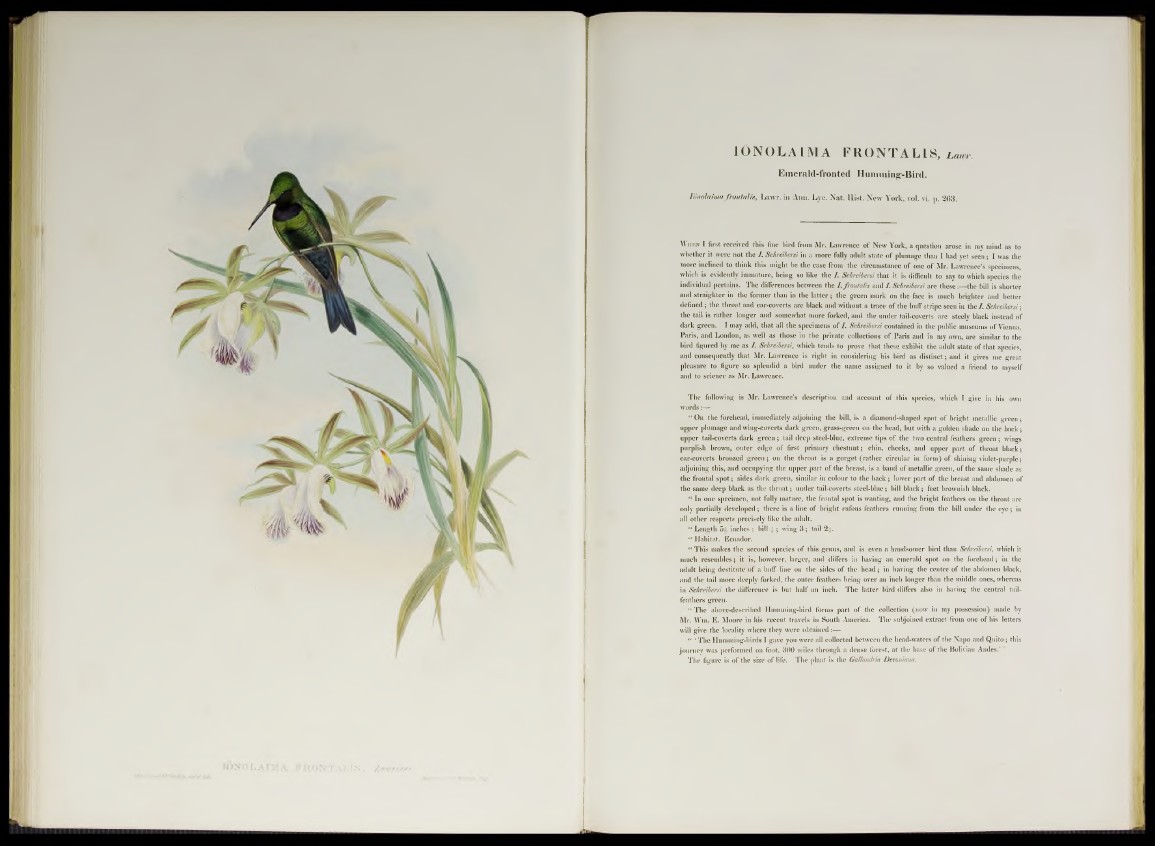
A L IS 9
IÖNOLAIMA FRONTALIS, Lam \
Einerald-fronted Humming*-Bird.
Iönolaima frontalis, Lawr. in Ann. Lyc. Nat. Hist. New York, vol. vi. p. 263.
W hen I first received tliis fine bird from Mr. Lawrence of New York, a question arose in ray mind as to
whether it were not the I. Schreibersi in a more fully adult state of plumage than I had yet seen; I was the
more inclined to think tliis might be the case from the circumstance of one of Mr. Lawrence’s specimens,
whicli is evidently immature, being so like the I. Schreibersi that it is difficult to say to which species the
individual pertains. The differences between the I. frontalis and I. Schreibersi are these:—the bill is shorter
and straighter in the former than in thé latter; the green mark on the face is much brighter and better
defined; the throat and ear-coverts are black and without a tracé of the buff stripe seen in the/. Schreibersi;
the tail is rather longer and somewhat more forked, and the under tail-coverts are steely black instead of
dark green. I may add, that all the specimens of /. Schreibersi contained in the public museums of Vienna,
Paris, and London, as well as those in the private collections of Paris and in my own, are similar to the
bird figured by me as I. Schreibersi, which tends to prove that these exhibit the adult state of that species,
and consequently that Mr. Lawrence is right in considering his bird as distinct; and it gives me great
pleasure to figure so splendid a bird under the name assigned to it by so valued a friend to myself
and to Science as Mr. Lawrence.
The following is Mr. Lawrence’s description and account of this species, which I give in his own
words:—
“ On the forehead, iinmediately adjoining the bill, is a diamond-shaped spot of bright metallic green;
upper plumage and wing-coverts dark green, grass-green on the head, but with a golden shade on the back;
upper tail-coverts dark green; tail deep steel-blue, extreme tips of the two central feathers green; wings
purplish brown, outer edge of first primary chestnut; chin, cheeks, and upper part of throat black;
ear-coverts bronzed green; on the throat is a gorget (rather circular in form) of shining violet-purple;
adjoining this, and occupying the upper part of the breast, is a band of metallic green, of the same shade as
the frontal spot; sides dark green, similar in colour to the back; lower part of the breast and abdomen of
the same deep black as the throat; under tail-coverts steel-blue; bill black; feet brownish black.
“ In one specimen, not fully mature, the frontal spot is wanting, and the bright feathers on the throat are
only partially developed; there is a line of bright rufous feathers running from the bill under the eye; in
all other respects precisely like the adult.
“ Length 5-±. inches ; bill -|-; wing 3 ; tail 2f.
“ Habitat. Ecuador.
“ This makes the second species of this genus, and is even a handsomer bird than Schreibersi, which it
much resembles; it is, however, larger, and differs in having an emerald spot on the forehead; in the
adult being destitute of a buff line on the sides of the head; in having the centre of the abdomen black,
and the tail more deeply forked, the outer feathers being over an inch longer than the middle ones, whereas
in Schreibersi the difference is but half an inch. The latter bird differs also in having the central tail-
feathers green.
“ The above-described Huinming-bird forms part of the collection (now in my possession) made by
Mr. Wm. E. Moore in his recent travels in South America. The subjoined extract from one of his letters
will give the locality where they were obtained:—
“ ‘ The Humming-birds I gave you were all collected between the head-waters of the Napo and Quito; this
journey was performed on foot, 300 miles through a dense forest, at the base of the Bolivian Andes.’ ”
The figure is of the size of life. The plant is the Gallandria Devoniana.